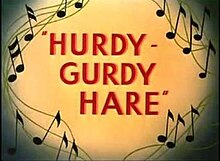| Hurdy-Gurdy Hare | |
|---|---|
 | |
| Directed by | Robert McKimson |
| Story by | Warren Foster |
| Starring | Mel Blanc |
| Music by | Carl Stalling |
| Animation by |
J.C. Melendez Emery Hawkins Charles McKimson John Carey Phil DeLara [1] |
| Layouts by | Cornett Wood |
| Backgrounds by | Philip DeGuard |
| Color process | Technicolor |
Production company | |
| Distributed by |
Warner Bros. Pictures The Vitaphone Corporation |
Release date | January 21, 1950 |
Running time | 6:57 |
| Language | English |
Hurdy-Gurdy Hare is a 1950 Warner Bros. Merrie Melodies cartoon short directed by Robert McKimson. [2] The short was released on January 21, 1950, and stars Bugs Bunny. [3]
In the film, Bugs works as a street musician with a trained monkey. He fires the monkey for stealing from him, then the monkey convinces a gorilla to confront Bugs for his behavior.
Plot
In Central Park, Bugs Bunny's foray into the world of street performance leads to a series of comedic misadventures. Initially enticed by the prospects of earning through a street organ, Bugs' ambition is fueled by the monetary success of his monkey assistant. However, disillusioned by the lack of generosity from passersby, Bugs dismisses the monkey and attempts the job himself, only to encounter a similar lack of financial reward.
The plot takes an unexpected turn when the disgruntled monkey seeks solace in the company of a gorilla at the zoo, embellishing his encounter with Bugs. Incited by the monkey's tale of mistreatment, the enraged gorilla breaks free and confronts Bugs. Employing his trademark wit and resourcefulness, Bugs orchestrates a series of comical exchanges to outmaneuver the formidable gorilla, ultimately resorting to trapping him within a makeshift brick wall. However, the resilient gorilla breaks free, leading to a climactic showdown where Bugs, faced with imminent danger, resorts to the universal language of music to pacify the savage beast. Utilizing the power of his violin performance, Bugs not only quells the gorilla's aggression but also inspires him to dance joyfully.
In a triumphant twist, Bugs capitalizes on the gorilla's newfound appreciation for music, orchestrating a lucrative scheme where the gorilla, accompanied by the monkey and the street organ, visits apartments, showering Bugs with a windfall of cash.
See also
References
- ^ "Vintage WARNER BROS CARTOONS INC Director Lead Sheet Robert McKimson BUGS BUNNY | #2022377549".
- ^ Beck, Jerry; Friedwald, Will (1989). Looney Tunes and Merrie Melodies: A Complete Illustrated Guide to the Warner Bros. Cartoons. Henry Holt and Co. p. 207. ISBN 0-8050-0894-2.
- ^ Lenburg, Jeff (1999). The Encyclopedia of Animated Cartoons. Checkmark Books. pp. 60–61. ISBN 0-8160-3831-7. Retrieved 6 June 2020.
- 1950 films
- 1950 animated films
- 1950 short films
- Merrie Melodies short films
- Films directed by Robert McKimson
- Bugs Bunny films
- Animated films about gorillas
- Films set in Manhattan
- Animated films set in New York City
- Films scored by Carl Stalling
- 1950s Warner Bros. animated short films
- Animated films set in parks
- Animated films set in zoos
- Animated films set in hotels
- 1950s English-language films
- Films with screenplays by Warren Foster
- Animated films about music and musicians